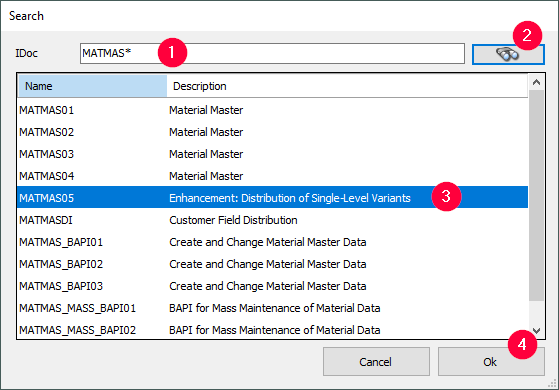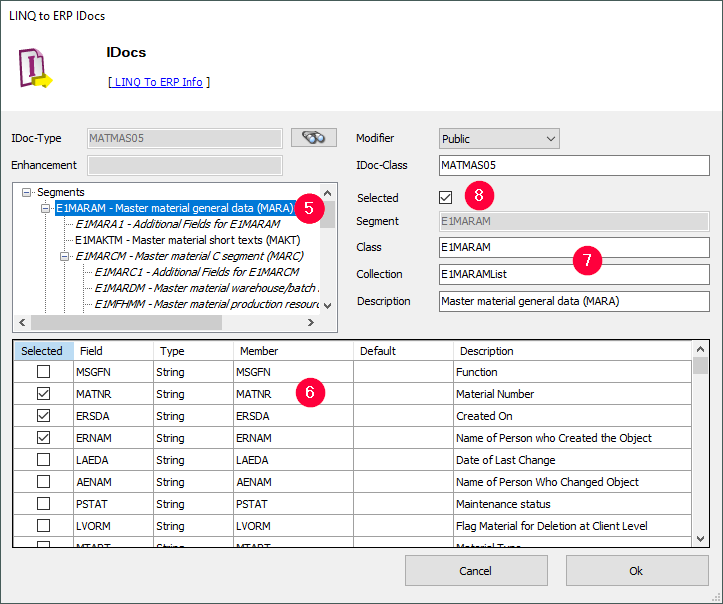Warning: Deprecated documentation
You are using the old version of the online help for ERPConnect.
Make sure to use the documentation within the new HelpCenter for ERPConnect.
The following section shows how to use the IDoc component of the LINQ to ERP toolbox.
With the IDoc component you can send IDocs to SAP. The segments of IDocs can be used in the SAP context.
Look Up an IDoc #
- Drag&Drop the IDoc component into the LINQ to ERP DataContext. A search window opens.
- Enter the name of the IDOC to be sent to SAP in the field IDoc (1). Use wildcards (*) if needed.

- Click [Search] (binoculars icon) (2). Search results appear in the preview window.
- Select an IDoc (3) and click [OK] (4) to proceed.
Edit an IDoc #
After an IDoc has been loaded, the window “LINQ to ERP IDocs” opens.
Use it to filter and rename the content of an IDoc:
- Select a segment you want to edit from the treeview (5). The fields of the segment are displayed in the lower area of the window.

- Uncheck unused fields or rename fields using the Member column (6).
- Optional: Rename the class name and collection names of the segment (7).
- Use the checkbox Selected to deactivate segments that are not used later in the code (8). Deactivated segments are displayed with italic font in the treeview.
- Click [OK] to confirm your selection. The window “LINQ to ERP IDocs” closes and a corresponding icon is created in the Designer.
To edit the IDoc, double-click the IDoc icon in the Designer.
How to Use the Class in your Code #
Save the .erp file that contains the extraction component to trigger the proxy classes code generation in the background.
In this example the IDoc component generates the following objects:
- an IDoc object (MATMAS05) including important header information (e.g. sender and receiver information e.g., RCVPRN or SNDPRN).
- the two Segments E1MARAM (Basicdata) and E1MAKTM (Shorttext) with the required fields already filled. They are also added to the IDoc.
The IDoc is sent with Send().
The following code shows how to use the generated classes:
static void Main(string[] args)
{
try
{
SAPContext sc = new SAPContext("User", "password");
sc.Connection.Open();
SAPContext.MATMAS05 MATMAS5 = new SAPContext.MATMAS05(sc.Connection);
SAPContext.E1MARAM E1MARAM = new SAPContext.E1MARAM();
SAPContext.E1MAKTM E1MAKTM = new SAPContext.E1MAKTM();
MATMAS5.RCVPRN = "T90CLNT090";
MATMAS5.RCVPRT = "LS";
MATMAS5.SNDPOR = "ERPTEST";
MATMAS5.SNDPRN = "ERPTEST";
MATMAS5.SNDPRT = "LS";
MATMAS5.MESTYP = "MATMAS";
E1MARAM.MATNR = "100-890";
E1MARAM.MEINS = "KG";
E1MARAM.MATKL = "001";
E1MARAM.GEWEI = "KG";
E1MARAM.MTART = "ROH";
E1MAKTM.MAKTX = "TestMat";
MATMAS5.E1MARAMList.Add(E1MARAM);
E1MARAM.E1MAKTMList.Add(E1MAKTM);
MATMAS5.Send();
Console.WriteLine("IDoc sent successfully"); Console.ReadLine();
}
catch (Exception e1)
{
Console.WriteLine(e1.Message); Console.ReadLine();
}
}
Check the result in SAP
The SAP transaction WE02 shows incoming IDocs. If the status is green, they are successfully processed.
